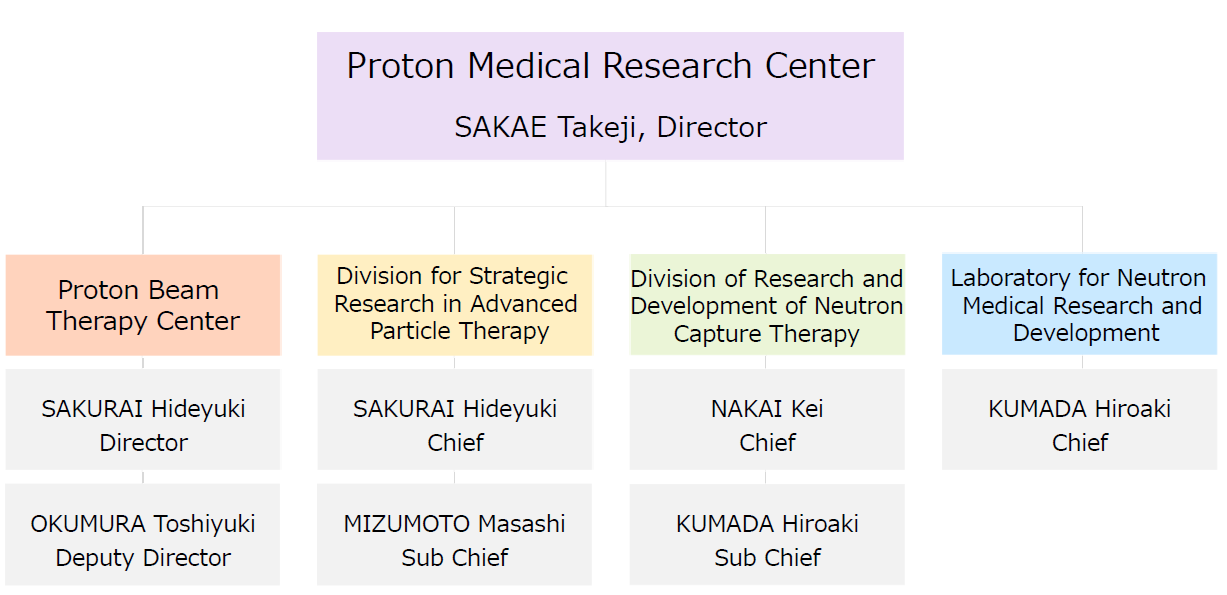
OUTLINE
Greetings
I have taken over from Dr. Koji Tsuboi as director of the Proton Medical Research Center.
The Center boasts a 35-year history, and is now approaching a very important time for future treatment continuation. Following the 18-year high-energy era, during which the Center led the world in establishing pioneering new treatments, we have used the current facility attached to the hospital for more than 17 years. In that facility, we have established a treatment record that demonstrates the benefits of proton therapy, which can suppress the side effects of cancer treatment, including in children, through the ability to irradiate tumor sites affected by respiratory motion. I imagine that problems caused by equipment aging will become apparent in a few years. There are still important issues to address, such as how to build the next era and what direction we should take in our research strategies, and the situation is such that we can’t afford to put these issues off.
I’m sometimes asked what the strengths are of the University of Tsukuba’s proton therapy. I’ll explain it briefly here. Although we didn’t publicize it enough in the past, the Center’s advanced treatments are characteristic. In addition, we have 30 years of experience performing these treatments. The development of irradiation of tumors in organs affected by respiratory motion, and a treatment setup using fluoroscopic X-ray images that move with respiration are two examples. These technologies, which are now standard therapies, have been used for many years and are directly linked to our accumulated clinical track record. Concepts originating from the Center, such as how particle beam-specific targets spread out and the problem of distortion of dose distribution caused by the overlay of small irradiation fields on organs with movement, were initially difficult for many researchers to understand and hence they were buried as information. But more than 15 years later, they are frequently discussed as new scanning irradiation technologies. The practice of these treatments has enhanced the technique and problem-solving capabilities of frontline treatment staff. For this reason, given an equivalent procedure, the time required for treatment preparation and irradiation is shorter, and the work is more efficient than at any other facility in the world. The Center’s strength is collaboration related to the movement of people on the treatment frontline, including team collaboration, collaboration across multiple job types, and communication with patients. The Center’s years of clinical results with proton beam therapy are based on cooperation among doctors in the hospital, in the surrounding area, and all over the country. Having many channels that can introduce patients is also one of our strengths. Another characteristic is our system of collaboration among three research groups: Radiation Oncology, Medical Physics, and Radiobiology. Thanks to system, we have provided professional education on proton beam therapy for some time, and have accepted many doctors, medical physicists, and radiology technicians as trainees. We have also accepted trainees from the UK, Germany, Australia, China, Taiwan, and other countries, and we believe that we should further enhance our English training courses in order to become an international educational base in the future.
One of the pillars of our research strategy is to develop a new device for boron neutron capture therapy (BNCT). The Center has a neutron capture therapy research and development department headed by Dr. Kei Nakai and a neutron medicine research and development laboratory headed by Dr. Hiroaki Kumada. We are promoting accelerator-driven equipment development and clinical research in collaboration with Ibaraki Prefecture and the High Energy Accelerator Research Organization (KEK). More than half of the students who enroll in the graduate school’s master’s and doctoral programs choose this new research subject, demonstrating the high level of interest both inside and outside the university. In addition, Dr. Toshiyuki Terunuma is developing markerless tracking technology as a strategic theme in research on particle beam therapy technology. This research is based on an unprecedented idea: to use multi-layer neural networks to track hard-to-see targets (cancers) and hidden targets in real time on fluoroscopic X-ray images with the aim of using it in a new generation of particle beam therapy. The world is also highly interested in deep learning and AI, and this is a new technology that is expected to become important in the future, and not only in this field.
I believe that what I need to do now is to work with all of the Center’s members to determine what we can do to make use of the Center’s strengths and to connect strategic research themes to the next generation of equipment. We will continue to collaborate with the numerous hospitals and research facilities that work with us, and I hope to identify new directions for this field. We look forward to continued cooperation in the future.
SAKAE Takeji
Director, Proton Medical Research Center
University of Tsukuba
Organization Chart

Staff
Research topics
The University of Tsukuba’s Proton Medical Research Center, led by Dr. Takeji Sakae, is conducting a variety of basic research projects, with the aim of establishing more efficient and safe proton beam therapy.
It also carries out clinical research, aimed at establishing more accurate treatments, in collaboration with the staff of the Proton Beam Therapy Center, which is a clinical department.